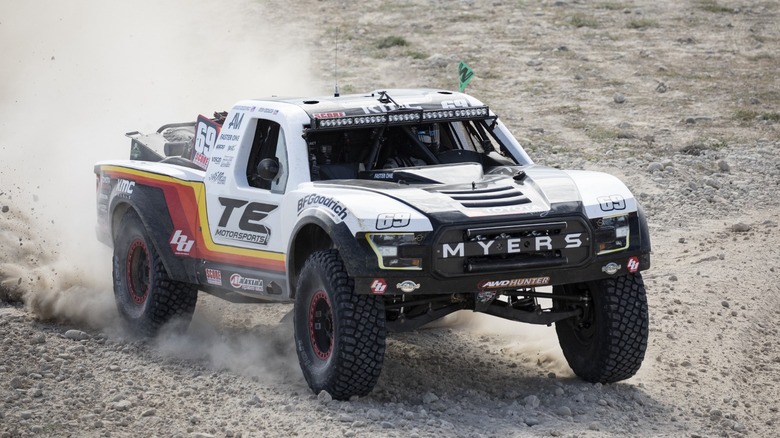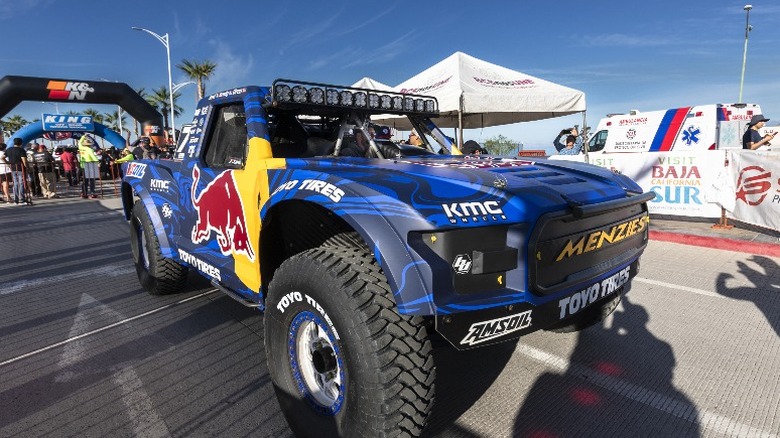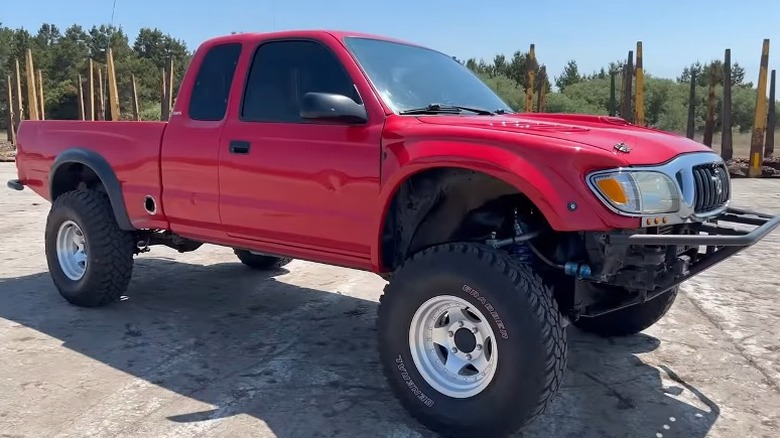Trophy Truck Vs. Prerunner: What's The Difference?
If you're into motorsports or have spent any time in the off-road scene, you've probably heard the terms "prerunner" and "trophy truck" tossed around quite a bit, and likely spotted them at the occasional race. If you've ever seen a prerunner and a trophy truck side by side, you may wonder what exactly the difference is between the two. Both types of trucks are used for off-road driving, usually in competitions, though they're popular among casual enthusiasts too. Both vehicles feature the mods every driver wants to take a truck off-road: tough fenders and bumpers, extreme lifts, beefy suspensions, etc.
However, there are differences between trophy trucks and prerunners. The most glaring difference between the two vehicles is their application. Trophy trucks are designed specifically for high-performance and off-road racing. Prerunners are more like practice cars that racers use to get a feel for the track before the actual race. The two also differ in performance level and parts. Let's take a deeper look and explore what makes these two trucks similar yet different.
What is a trophy truck?
A trophy truck — also known as a trick truck — is a highly modified pickup truck designed for off-road performance driving. Drivers and race teams typically use these vehicles for off-road desert races: Check out our take on Open Wide at Baja for a look at that. Some of the defining features of a trophy truck include a custom chassis built with durable metal tubing, powerful V8 engines capable of 700-800 horsepower, beefy suspension systems with multiple shocks, and oversized tires with thick, heavy tread. Trophy trucks are capable of extreme speeds, regularly reaching 120 mph or more, and must run for sustained periods, often more than 1,000 miles at a time. Because of this, they must be highly durable and capable of standing up to the harsh heat, dust, and driving conditions of desert races. It's not uncommon for professional trophy trucks to cost more than $1 million to build. That price doesn't even factor in maintenance costs: fuel, fees, spare parts, crew costs, and more.
In short, trophy trucks are designed to win races. The trucks are built using the best parts available, and since they run extreme endurance races — often more than 1,000 miles over the course of a 24-hour window — contain highly specialized components for endurance, performance, and power.
What is a prerunner?
Like trophy trucks, prerunners are built for off-road driving, typically in a desert environment. As implied by the name, prerunners are designed to pre-run a race. Drivers use prerunners to get a feel for the race track before the actual event. It's an essential step allowing drivers to learn the course, identify hazards, and plot the quickest, safest route to the finish line.
When it comes to design, prerunners and trophy trucks look alike. Both typically feature flared fenders, roll cages, beefed-up suspension systems, and large off-road tires. However, much less money goes into building prerunners. Prerunners don't need to win races; that's what the trophy truck is for. Prerunners have to handle the same harsh desert conditions as trophy trucks, but don't have or need the same level of performance.
A final difference between prerunners and trophy trucks has to do with their accessibility to average drivers. While trophy trucks may cost upwards of $1 million to build and maintain, DIYers and off-road enthusiasts can build modest prerunners for much less money. Most prerunners are built on normal pickups from major truck brands, like the Toyota Tacoma and Ford Ranger and F-150. In desert states like the U.S. Southeast, prerunners are familiar sights, and you'll frequently encounter gearheads who use prerunners as their daily drivers during the week before hitting the desert trails on the weekend.


